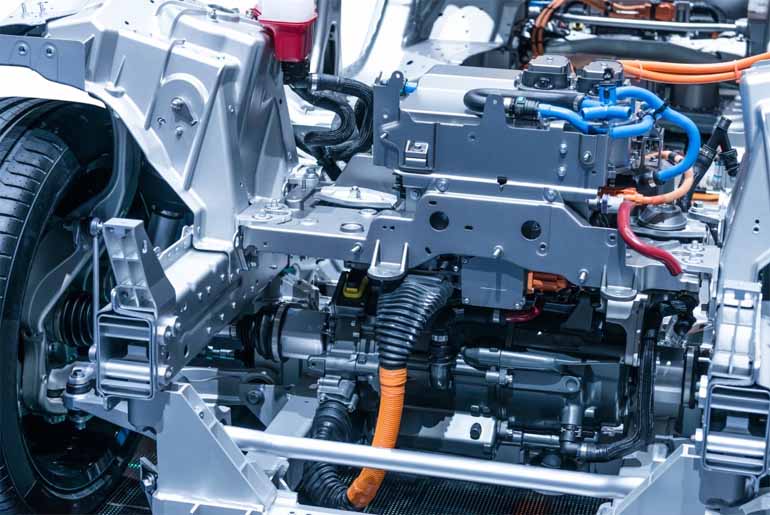The rapid adoption of electric vehicles (EVs) has not only revolutionized the automotive industry but also transformed the underlying technology that powers these vehicles. One key component that has seen significant evolution in EVs is the transmission system. Unlike traditional internal combustion engine (ICE) vehicles, where the transmission system is crucial for delivering power across a wide range of speeds and loads, EVs have unique requirements and opportunities for innovation in this area. This article explores the evolution of EV transmission systems, key trends, and the latest innovations shaping the future of electric mobility.
The Basics: Transmission in Internal Combustion vs. Electric Vehicles
In conventional ICE vehicles, the transmission system plays a critical role in managing the engine’s power output to provide the necessary torque and speed to the wheels. The engine operates efficiently within a narrow band of RPMs, so a multi-gear transmission is required to keep the engine within this range while delivering the desired speed and performance.
In contrast, electric motors used in EVs generate maximum torque from zero RPM and maintain high efficiency over a broad range of speeds. This characteristic allows for simpler transmission systems. Most early EVs and many current models utilize a single-speed transmission, which simplifies design, reduces weight, and lowers production costs while still delivering impressive acceleration and performance.
Evolution of EV Transmission Systems
-
Single-Speed Transmission: The Standard
The simplicity and effectiveness of single-speed transmissions made them the default choice for early EVs. These systems allow the electric motor to directly drive the wheels with no need for gear changes. The immediate torque provided by the electric motor eliminates the need for a complex transmission system, leading to cost savings and improved reliability.
Single-speed transmissions have been sufficient for many EV applications, particularly in city driving and for vehicles designed for efficiency over performance. However, as EV technology has advanced and consumer expectations have grown, there has been a push for more sophisticated transmission systems to enhance performance and efficiency across a broader range of driving conditions.
-
Multi-Speed Transmissions: Expanding Capabilities
As EVs began to target more diverse markets, including high-performance segments, the limitations of single-speed transmissions became more apparent. Multi-speed transmissions started to emerge, offering enhanced efficiency and performance, particularly at high speeds. By allowing the motor to operate closer to its optimal efficiency point across different driving scenarios, multi-speed transmissions can improve range and overall driving experience.
One example of this trend is Porsche’s Taycan, which utilizes a two-speed transmission on the rear axle. The first gear provides rapid acceleration, while the second gear enables higher efficiency and top speed. This dual-gear setup allows the Taycan to deliver both performance and efficiency, demonstrating the potential benefits of multi-speed transmissions in EVs.
-
Direct Drive and Hub Motors: Simplification and Integration
Another significant innovation in EV transmission systems is the development of direct drive and in-wheel (hub) motors. Direct drive systems eliminate the need for a conventional transmission by integrating the motor directly with the wheel or axle, reducing mechanical losses and simplifying the drivetrain.
Hub motors take this concept further by placing the motor inside the wheel itself. This approach offers several advantages, including increased efficiency, greater design flexibility, and improved weight distribution. However, hub motors also present challenges, such as increased unsprung weight, which can affect handling and ride comfort.
Despite these challenges, hub motors are gaining traction, particularly in applications like electric buses and delivery vehicles, where their benefits in terms of packaging and efficiency outweigh the drawbacks.
-
Innovative Cooling and Lubrication Systems
As EV transmission systems evolve, managing heat and ensuring efficient lubrication have become critical areas of innovation. Electric motors and transmissions generate significant heat, which can reduce efficiency and performance if not properly managed. Advanced cooling systems, including liquid-cooled motors and transmissions, are being developed to address these challenges.
Additionally, new lubrication technologies are being explored to reduce friction and wear in multi-speed transmissions, improving their efficiency and longevity. These innovations are particularly important as EVs continue to push the boundaries of performance and range.
Key Trends Shaping the Future of EV Transmissions
-
Increased Focus on Efficiency
As the demand for longer-range EVs grows, improving the efficiency of all vehicle components, including the transmission, becomes increasingly important. Future transmission systems are likely to incorporate advanced materials, precision engineering, and smart control algorithms to minimize energy losses and maximize overall vehicle efficiency.
-
Integration with Advanced Powertrain Technologies
The next generation of EV transmissions will likely be more closely integrated with other powertrain components, such as electric motors and battery management systems. This integration will enable more sophisticated energy management strategies, optimizing the interaction between the transmission, motor, and battery to improve performance and range.
-
Customization and Flexibility
As EVs proliferate across different vehicle segments, from compact city cars to heavy-duty trucks, transmission systems will need to be adaptable to different performance requirements. Modular transmission designs, which can be tailored to specific applications, are likely to become more common. This trend will allow manufacturers to offer a wider range of EVs, each optimized for its intended use case.
-
Advancements in Software and Control Systems
Software will play an increasingly important role in the evolution of EV transmissions. Advanced control systems will enable real-time optimization of the transmission’s performance based on driving conditions, vehicle load, and battery state. Machine learning and AI could also be leveraged to predict and adapt to driver behavior, further enhancing efficiency and driving experience.
Conclusion
The evolution of EV transmission systems reflects the broader transformation of the automotive industry toward electrification. From the simplicity of single-speed transmissions to the sophistication of multi-speed gearboxes, direct drive systems, and hub motors, the development of EV transmission technology continues to push the boundaries of performance, efficiency, and innovation. As the industry evolves, these transmission systems will play a crucial role in defining the capabilities of future electric vehicles, contributing to a more sustainable and electrified future of mobility.

